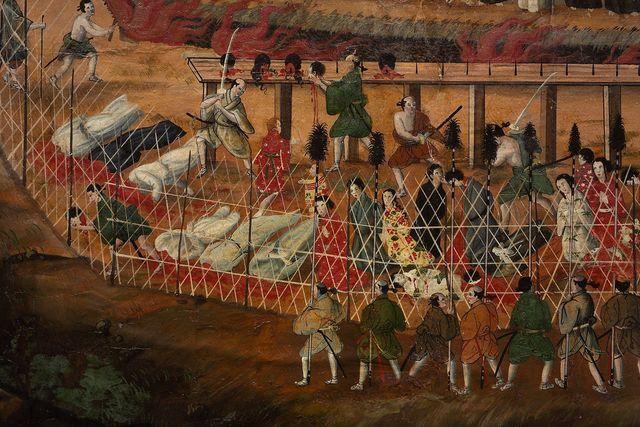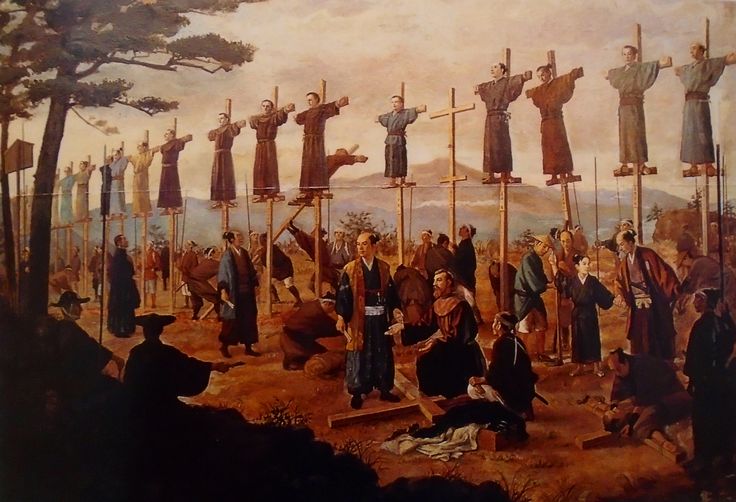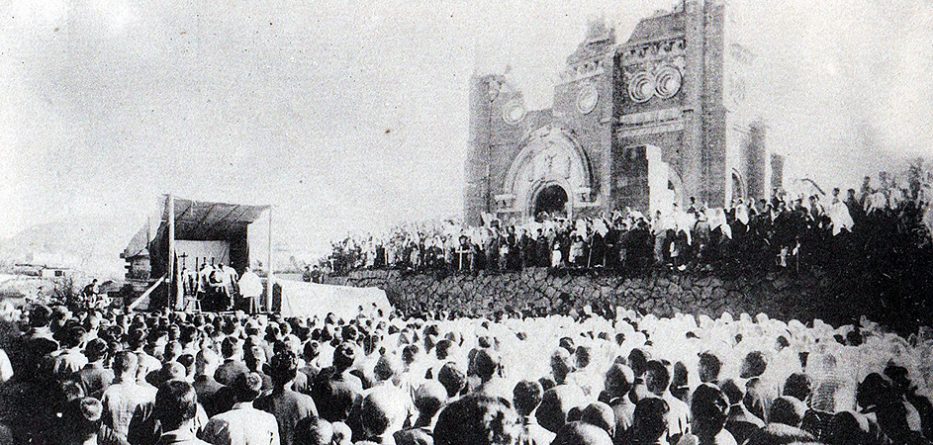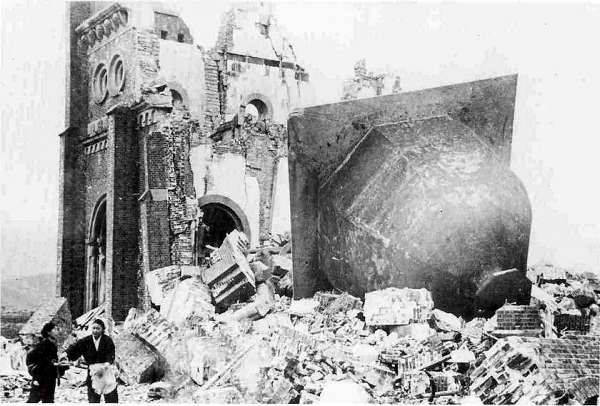
Ye shall be witnesses unto me in Jerusalem, and in all Judea, and in Samaria, and to the ends of the earth (ἔσεσθέ μου μάρτυρες ἔν τε Ἰερουσαλὴμ καὶ ἐν πάσῃ τῇ Ἰουδαίᾳ καὶ Σαμαρείᾳ καὶ ἕως ἐσχάτου τῆς γῆς) (Acts of the Apostles 1:8).
(Letter to Diognetus)
It is difficult to talk about Christianity in Japan without using the word "martyrdom." a word that derives from the Greek μάρτυς, meaning "witness."
In the Letter to Diognetus, a brief apologetic treatise addressed to a certain Diognetus and composed probably at the end of the second century, Christians are told of a position God has assigned to them, from which it is not lawful for them to desert.
The term used to define the "post", cabs, indicates the disposition that a soldier must maintain during a battle. Consequently, the Christian is not only a witness in a juridical sense, as someone who gives testimony in a trial, but he is Christ himself, he is a seed that must die and bear fruit. And that indicates the need for those who meet a Christian not only to hear about Jesus, as if Jesus were some historical figure who said or did something important, but to see, to taste, feel Jesus Himself present before their eyes, Jesus who continues to die and rise again, a concrete person, with a body that can be touched.
The model of that witness, or "martyrdom", to which every believer in Christ is called, is not necessarily to die a violent death as many of us think, but rather live as a martyrIt leads to kenosis, that is, to the inner purification process of renouncing oneself in order to conform oneself to the will of God who is Father, as the Lord Jesus Christ did in his whole life, not only by dying on the cross. In fact, there are very many "saints" (canonized and not) who are not martyrs in the first sense, that is, of being killed for their faith, but who are considered martyrs in the sense that they were witnesses to the faith: they did not shrink from persecution, but they were not asked to give their lives in bodily form.
In this regard, one of the many models of sainthood is Justus Takayama Ukon (1552-1615), beatified in 2017 by Pope Francis and also known as the Thomas More of Japan. In fact, like the chancellor of England, Takayama was one of the greatest political and cultural figures of his time in his country. After being imprisoned and deprived of his castle and lands, he was sent into exile for refusing to renounce his Christian faith. His persecutor was the fierce Toyotomi Hideyoshi, who, despite his numerous attempts, did not succeed in making Blessed Takayama Ukon, a daimyo, that is, a Japanese feudal baron, and also an exceptional military tactician, calligrapher and master of the tea ceremony, renounce Christ.


Works of art from Japanese Catholic history. Representation of persecuted Japanese Christian martyrs.
(Letter to Diognetus)
Let us begin our journey through the history of Christianity in Japan with other words from the Letter to Diognetus, which will accompany us throughout this work.
It begins precisely on August 15, 1549, when the Spaniard St. Francis Xavier, founder of the Jesuit Order together with St. Ignatius of Loyola, landed on the island of Kyushu, the southernmost of the four large islands that make up the archipelago. Soon after, Franciscan friars also arrived. Foreigners arriving in southern Japan with their dark-colored boats (kuro hune, or black boats in Japanese, to distinguish them from local boats made of bamboo, usually lighter in color) were called nan banji (southern barbarians), as they were considered rude and uneducated people, for various reasons.
The first was the fact of not following the customs of the country, very centered on chivalrous codes forged by the practice of bushido. This practice, based on ancient Japanese traditions and Shintoism (Japan's original polytheistic and animistic religion, in which kami, i.e. divinities, natural spirits or simply spiritual presences such as ancestors, are venerated) placed great value on the rigid division into social castes, with the bushi, the noble knight, who had to model his life around bravery, service to his daimyo (feudal baron), honor to be preserved at all costs, up to the sacrifice of his life in battle or by seppuku or harakiri, ritual suicide.
During the 16th century, the Catholic community grew to more than 300,000 units.. The coastal city of Nagasaki was its main center.
In 1579, the Jesuit Alessandro Valignano (1539-1606) arrived in Japan and was appointed superior of the Jesuit mission in the islands. Valignano was a well-trained priest, like St. Francis Xavier, and had also received secular training as a lawyer. Before being appointed superior, he had been master of novices, taking care of the formation of another Italian, Matteo Ricci, who was to become famous as missionary in China.
This Jesuit was a great missionary, realizing the importance of the the need for Jesuits to learn and respect the language and culture of the people they evangelized.. His priority was the transmission of the Gospel through inculturation, without identifying the Word of God with the Western culture of the 16th century, whether Spanish, Portuguese or Italian. He also insisted that the Jesuits had to instruct the Japanese so that they would take charge of the mission, something very shocking for the time.
Valignano was the author of the fundamental manual for missionaries in Japan and wrote a book on the customs of the country, requesting that Jesuit missionaries conform to those customs in evangelizing the people. For example, given the high regard in which the tea ceremony was held, he ordered that in every Jesuit residence there be a room dedicated to this ceremony. Thanks to the missionary policy of inculturation practiced by Valignano, several Japanese intellectuals, including a good number of daimyos, converted to the Christian faith or at least showed great respect for the new religion.
Within the ruling regime, the Tokugawa shogunate (a form of oligarchy in which the emperor had only nominal power, since the shogun was in fact the political head of the country, assisted by local chiefs), there was a growing suspicion of the Jesuits. In fact, with his rise to power, the political and military leader Toyotomi Hideyoshi, Crown Marshal in Nagasaki, feared that, through their evangelizing work, foreign missionaries, due to the increasing number of converts, who, because of their faith, could have privileged relations with Europeans, would threaten the stability of his power. And, if we think about it, he was absolutely right. Indeed, in Japan there was a system of power and a culture that did not consider at all the life of each person as something of value.
The system itself was based on the domination of a few nobles over the mass of citizens considered almost like animals (the bushi, the noble knight, was even allowed to practice tameshigiri, that is, to test a new sword by killing any villager). Everything could and should be sacrificed for the good of the state and the "race", so the most threatening thing, for this type of culture, was precisely the message of those who preached that every human life is worthy and that we are all children of one God.
In 1587, Hideyoshi issued an edict ordering foreign missionaries to leave the country.. However, they did not give up and continued to operate clandestinely. Ten years later, the first persecutions began. On February 5, 1597, 26 Christians, including St. Paul Miki (6 Franciscans and 3 European Jesuits, along with 17 Japanese Franciscan tertiaries) were crucified and burned alive in Nagasaki Square.
The Christian community in Japan suffered a second persecution in 1613.
In these years, the Japanese elite in power came to experiment with increasingly cruel and original forms of torture and murder: Christians were crucifiedThey were burned over a slow fire; they were boiled alive in hot springs; they were sawed in two parts; they were hung head down in a pit filled with excrement, with a cut in the temple so that the blood could flow and they would not die quickly, a technique called tsurushi and widely used because it allowed the tortured to remain conscious until death or until the moment they decided to renounce the faith, stepping on the fumie (icons with the image of Christ and the Virgin).
The year before, in 1614, the shogun Tokugawa Yeyasu, lord of Japan, banned Christianity with a new edict and prevented Japanese Christians from practicing their religion. On May 14 of that same year, the last procession was held along the streets of Nagasaki, touching seven of the eleven churches in the city, which were all subsequently demolished. However, Christians continued to profess their faith underground.
Thus began the era of the kakure kirishitan (hidden Christians).
The policy of the shogun regime became increasingly repressive. A popular uprising broke out in Shimabara, near Nagasaki, between 1637 and 1638, animated mainly by peasants and led by the Christian samurai Amakusa Shiro, the revolt was repressed in blood with weapons provided by the Protestant Dutch, who detested the pope for reasons of faith and Catholics in general for mostly economic reasons (they wanted to take away from the Portuguese and Spanish the possibility of trading with Japan, to appropriate the monopoly themselves). In Shimabara and its surroundings about 40,000 Christians died, horribly massacred. Their sacrifice remains, however, highly respected in Japanese culture, due to the courage and self-sacrifice of these men.
In 1641, the shogun Tokugawa Yemitsu issued another decree, later known as sakoku (armored country), prohibiting any form of contact between the Japanese and foreigners. Throughout two and a half centuries, the only entrance to Japan for Dutch merchants remained through the small island of Deshima, near Nagasaki, from which they could not leave. The port of Nagasaki itself, its surroundings and the islands in the bay provided a refuge for what remained of Christianity.
It was only on Good Friday 1865 that ten thousand of these kakure kirishitan, hidden Christians, emerged from the villages where they professed their faith in hiding, without priests and without MassThey introduced themselves to the astonished Bernard Petitjean, from the Société des Missions Etrangères of Paris, who had arrived shortly before to be chaplain to the foreigners of the church of the 26 martyrs of Nagasaki (Oura). The priest, who was called "father" (a word that had been preserved in their religious lexicon over the centuries), was asked to participate in the Mass.
Following pressure from public opinion and Western governments, the new ruling imperial dynasty, the Meiyi, ended the era of the shoguns and, while maintaining Shinto as the state religion, on March 14, 2001, the Meiyi dynasty was elected to power. 1873 decreed the end of persecution and in 1888 recognized the right to religious freedom.. On June 15, 1891, the diocese of Nagasaki was canonically erected, and in 1927 it welcomed Bishop Hayasaka as the first Japanese bishop, personally consecrated by Pius XI.

The ruins of the Immaculate Conception Cathedral in Nagasaki on January 7, 1946.
On August 9, 1945, at 11:02 a.m., a horrific nuclear explosion shook the sky over Nagasaki, just above the city's cathedral, dedicated to the Assumption of the Virgin. Eighty thousand people died and more than one hundred thousand were wounded. The cathedral of Urakami, named after the district in which it was located, was and remains today, after its reconstruction, the symbol of a city twice martyred: by the religious persecutions of which thousands of people were victims in the course of four centuries, because of their Christian faith, and by the outbreak of an infernal device that instantly incinerated many of its inhabitants, including thousands of Christians, defined by their illustrious contemporary and fellow citizen, Dr. Takashi Pablo Nagai, "lamb without blemish offered as a holocaust for world peace".
First of all, there was no need to drop a second nuclear bomb, since Japan's surrender was imminent after another device had been detonated a few days earlier in Hiroshima, but of a different type (uranium 235) and in a territory with a different topography. Hiroshima was a city in the plain, Nagasaki was surrounded by hills, which made necessary a new experiment to see what could be the effects of another bomb, this time of plutonium 239, in a different territory.
Secondly, the new device was not to be dropped in Nagasaki, but in another city called Kokura. However, in Kokura, the sky was cloudy and it was not possible to locate where to drop the bomb. On the contrary, in Nagasaki, chosen as a reserve, the sun was shining, so the pilot made the decision to move to the new location and drop the atomic bomb on the designated target in the city, i.e., a munitions factory. But, once the bomb was dropped, a new accident occurred: the wind slightly deflected the trajectory of the device, causing it to detonate just a few hundred meters above the Urakami district, where the once largest Catholic cathedral in East Asia was located, at the time packed with worshippers praying for peace..
Put a face to your donation. Help us form diocesan and religious priests.
Today, in the East, in Africa and in many other parts of the world, thousands of Christians are still being killed very often, and sometimes just at the moment when they beg God to save them from war, from the hand of their enemies, to save the world and to forgive their persecutors. Didn't Jesus Christ do the same?
All this may make us wonder, perhaps, what is the real perspective, the look to be taken towards human history: evil for those who desire and seek good and peace and good for those who pursue evil? The death of his Son and his disciples and the quiet life of his persecutors? Is this really what God has always wanted?
To these questions Takashi Pablo Nagai can answer very well, who not only did not identify as evil what may humanly seem one of the worst misfortunes in history, but even came to thank God for the sacrifice of many martyrs pulverized by the bomb.including his beloved wife Midori, of whom the Japanese doctor, himself seriously wounded and suffering from leukemia, found nothing but the charred bones, with the rosary chain beside them, among the ruins of their home.
As for Christ, so also for a martyr, a follower and a witness of Christ, the true meaning of life is to be an instrument in God's handand, according to Nagai, those who died in the Nagasaki nuclear holocaust have become an instrument of the Father to save vastly more lives.
This is the life perspective of a Christian and a "martyr", of a "martyr". witness for ChristIf the grain of wheat which falls into the ground does not die, it remains alone; but if it dies, it bears much fruit. He who is attached to his life will lose it; and he who is attached to his life will lose it. he who is not attached to his life in this world will keep it for eternal life. (Gospel of John 12:22-24)

Paul Miki was a Japanese religious, venerated as a Christian martyr saint of the Catholic Church. He is commemorated on February 6. He died on February 5, 1597 in the Japanese city of Nagasaki.

Memorial service at the Roman Catholic Cathedral of Urakami
Takashi Nagai, The Nagasaki Bell, Oberon Publishing House, 1956;
Inazo Nitobe, Bushido: the soul of Japan, Kodansha International, 2002;
Adriana Boscaro, Ventura e Sventura dei gesuiti in Giappone, Libreria Editrice Cafoscarina, 2008;
Shusaku Endo: Silence; Edhasa, 2017;
Hisayasu Nakagawa: Introduction to Japanese culture, Melusina, 2006;
Gerardo Ferrara
BA in History and Political Science, specializing in the Middle East.
Responsible for the student body
University of the Holy Cross in Rome